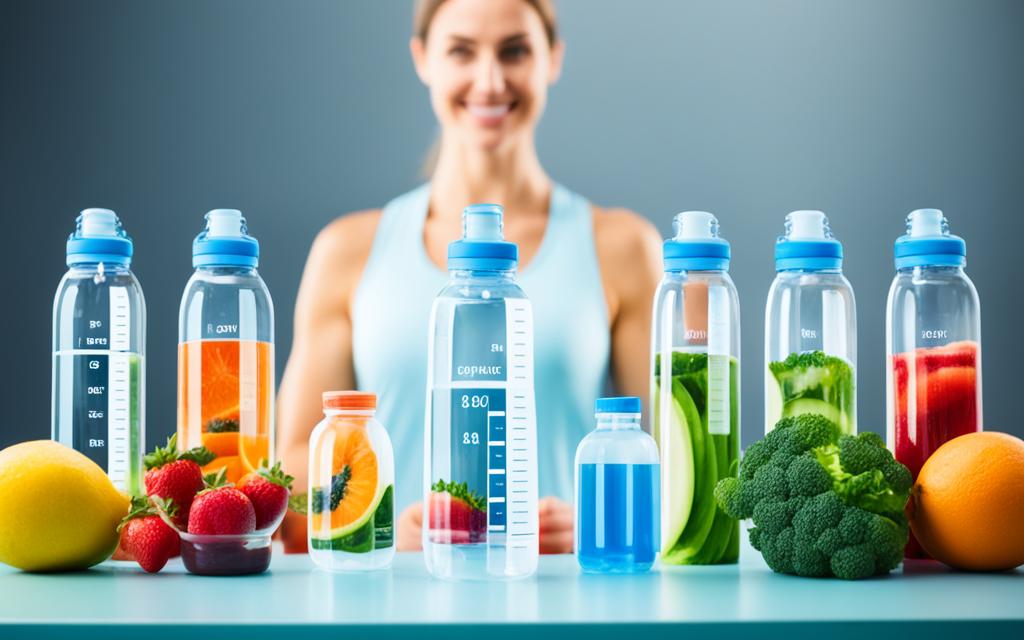Staying hydrated is essential for maintaining a healthy lifestyle. But how much water should you be drinking each day in ounces? In this section, we will explore the recommended daily water intake to help you understand the optimal water consumption in fluid ounces.
Key Takeaways:
- Drinking enough water is crucial for overall health and wellness.
- The recommended daily water intake varies based on factors such as body weight, activity levels, and climate conditions.
- On average, it is suggested that individuals consume at least 64 ounces of water per day.
- Listen to your body and adjust your water intake accordingly, especially during strenuous physical activity or in hot weather.
- Remember that other fluids and hydrating foods also contribute to your daily water intake.
Why is Water Intake Important for Your Health?
In order to maintain optimal health, it is crucial to understand the significance of water intake. Water serves many important functions in the body and plays a vital role in various physiological processes. Let’s explore why staying properly hydrated is essential for your overall well-being.
1. Hydration and Body Functions
Water is essential for the proper functioning of your body. It helps regulate body temperature, lubricates joints, and aids in digestion and nutrient absorption. Additionally, water plays a key role in transporting nutrients and oxygen to cells and removing waste products.
2. Maintaining Fluid Balance
Drinking an adequate amount of water is essential for maintaining fluid balance in the body. When you are dehydrated, your body’s fluid balance is disrupted, leading to various health issues. Proper hydration helps ensure that your body can carry out its functions efficiently.
3. Energy and Cognitive Function
Dehydration can negatively impact both your physical and mental performance. Studies have shown that even mild dehydration can lead to fatigue, decreased cognitive function, and poor concentration. By staying hydrated, you can maintain optimal energy levels and support cognitive function.
4. Skin Health and Appearance
Water plays a crucial role in maintaining healthy skin. It helps hydrate the skin cells, improve elasticity, and flushes out toxins, promoting a clear and youthful complexion. Proper hydration can also reduce the risk of skin issues such as dryness and acne.
To ensure you meet your daily hydration needs, it is important to follow water intake guidelines. The recommended daily water intake for adults varies, but a general guideline is to consume around 64 ounces of water per day. However, individual water requirements may vary based on factors such as age, weight, physical activity level, and climate.
| Age Group | Recommended Daily Water Intake (ounces) |
|---|---|
| Adults (18 years and older) | 64 ounces (8 cups) |
| Children (4-8 years) | 40 ounces (5 cups) |
| Adolescents (9-13 years) | 64-88 ounces (8-11 cups) |
| Teenagers (14-18 years) | 68-96 ounces (8.5-12 cups) |
Remember, these guidelines are just a starting point, and individual water requirements may vary. It is important to listen to your body’s signals and adjust your water intake accordingly.
By prioritizing your daily water intake, you can support your overall health and well-being. Stay hydrated and reap the numerous benefits that water has to offer.
Factors Affecting Your Water Consumption
Several factors can influence your water consumption, including physical activity, climate, and personal health needs. Understanding these factors is essential for determining the ideal water intake per day in ounces.
1. Physical Activity
Engaging in physical activity increases your body’s water requirements. When you exercise, you lose fluids through sweat, making it crucial to replenish your body’s water supply. It’s recommended to consume additional water before, during, and after your workout session to stay properly hydrated.
2. Climate
The climate you live in also plays a significant role in your daily water volume in fluid ounces. In hot climates or during periods of high temperatures, your body loses more water through sweating, making it essential to increase your fluid intake to prevent dehydration. On the other hand, in colder climates, you may not feel as thirsty, but it’s still important to drink an adequate amount of water.
3. Personal Health Needs
Individuals with certain health conditions may have specific water consumption recommendations in ounces. For instance, those with kidney stones or urinary tract infections may require higher water intake to prevent these conditions from recurring. Additionally, pregnant or breastfeeding women may need to increase their water consumption to support their changing body’s needs.
Considering these factors and maintaining an ideal water intake per day in ounces will help you stay hydrated and promote overall health and well-being.
Determining Your Personal Water Requirements
Calculating your daily water intake is essential for maintaining optimal hydration and overall health. Your individual water requirements can vary based on factors such as body weight, activity levels, and climate conditions. By understanding these factors, you can determine the optimal water consumption in fluid ounces that suits your specific needs.
Factors to Consider for Determining Water Requirements:
When determining your personal water requirements, consider the following factors:
| Factors | Description |
|---|---|
| Body Weight | Your body weight plays a significant role in determining your water intake needs. As a general guideline, consume half an ounce to an ounce of water for every pound of body weight. For example, if you weigh 150 pounds, your daily water intake should range from 75 to 150 ounces. |
| Activity Levels | Physical activity increases your body’s water loss through sweat. It’s important to replenish the lost fluids by increasing your water intake. A good rule of thumb is to consume an additional 12 to 16 ounces of water for every 30 minutes of exercise. |
| Climate Conditions | In hot or humid weather, your body tends to sweat more, leading to increased water loss. To compensate for this, it’s crucial to drink more fluids to maintain proper hydration. Aim to consume an extra 8 to 16 ounces of water in such conditions. |
| Individual Health Needs | Some individuals may have specific health conditions that require them to adjust their water intake. For example, certain medications or medical conditions may increase the need for hydration. Consult with your healthcare provider for personalized recommendations. |
By taking these factors into account, you can determine your daily water intake in ounces that align with your body’s needs. Ensuring you meet the optimal water consumption in fluid ounces will help you maintain proper hydration levels and support overall well-being.
Tips for Meeting Your Daily Water Intake
Ensuring you meet your daily hydration needs is essential for maintaining overall health and well-being. Here are some practical tips and strategies to help you reach your ideal water intake per day:
Incorporate Hydrating Foods
Aside from water itself, many foods can contribute to your daily water consumption. Incorporating hydrating foods into your diet can help you stay hydrated throughout the day. Opt for fruits and vegetables with high water content, such as:
| Fruit | Water Content (%) |
|---|---|
| Watermelon | 92 |
| Strawberries | 91 |
| Cucumber | 95 |
| Lettuce | 96 |
You can also enjoy soups, smoothies, and herbal teas to increase your daily fluid intake.
Create a Hydration Routine
Establishing a hydration routine can help you stay on track with meeting your daily water intake goals. Consider the following strategies to incorporate into your routine:
- Start your day with a glass of water to jumpstart hydration.
- Keep a reusable water bottle with you at all times for easy access to hydration.
- Set reminders or use hydration apps to prompt you to drink water throughout the day.
- Sip water before, during, and after physical activity to replenish lost fluids.
By implementing these tips and strategies, you can ensure you meet your daily water consumption recommendations in ounces and maintain optimal hydration levels for overall health.
Common Myths About Water Consumption Debunked
There are many misconceptions and myths surrounding water consumption. It’s time to separate fact from fiction and debunk these common myths based on scientific research. Let’s explore the truth behind some of the most prevalent misunderstandings about water intake guidelines:
Myth #1: The 8×8 Rule
One of the most widely believed myths is that you need to drink eight 8-ounce glasses of water per day, also known as the 8×8 rule. However, this guideline lacks scientific evidence and fails to consider individual variations in daily water volume needs.
Myth #2: Drinking Too Much Water is Harmless
Contrary to popular belief, excessive water intake can actually be detrimental to your health. Drinking excessive amounts of water can lead to a condition called hyponatremia, where the sodium levels in your blood become dangerously low. It is essential to strike a balance and consume water in moderation.
Myth #3: You Only Need Water When You’re Thirsty
While thirst is a reliable indicator that your body needs hydration, relying solely on thirst can be problematic. Thirst is often a delayed response, meaning that by the time you feel thirsty, you may already be mildly dehydrated. It is advisable to establish a regular hydration routine and drink water throughout the day, even if you don’t feel thirsty.
Myth #4: All Fluids Contribute Equally to Hydration
While staying adequately hydrated is important, not all fluids contribute equally to your hydration needs. Beverages that contain caffeine or alcohol can actually have a diuretic effect and increase fluid loss. Water remains the best choice for optimal hydration.
Myth #5: Foods Provide Enough Water
While it’s true that certain fruits and vegetables have high water content and can contribute to your daily hydration needs, relying solely on food for water intake is insufficient. The majority of your daily water intake should come from fluids to ensure adequate hydration.
Now that we’ve debunked these common myths, it is important to rely on scientific-backed guidelines for daily water intake. Let’s take a look at the recommended daily water intake in ounces:
| Age Group | Recommended Daily Water Intake (Fluid Ounces) |
|---|---|
| Adult Males | Approximately 13 cups (104 oz) |
| Adult Females | Approximately 9 cups (72 oz) |
| Children (4-8 years) | Approximately 5 cups (40 oz) |
| Adolescents (9-13 years) | Approximately 7-8 cups (56-64 oz) |
Remember, these guidelines can vary depending on factors such as activity level, climate, and overall health. It’s always a good idea to consult with your healthcare provider to determine the ideal water intake for your specific needs.
Signs of Dehydration and How to Stay Hydrated
Proper hydration is essential for maintaining overall health and well-being. By recognizing the signs of dehydration and implementing effective hydration strategies, you can ensure that you meet your daily hydration needs in ounces and optimize your water consumption in fluid ounces.
Signs of Dehydration
Dehydration occurs when your body doesn’t have enough water to function properly. It’s important to be aware of the signs of dehydration so that you can take prompt action to rehydrate. The following are common signs of dehydration:
| Signs of Dehydration | Description |
|---|---|
| 1. Thirst | A dry sensation in the mouth and throat, accompanied by a strong urge to drink. |
| 2. Dark Urine | Urine that is darker in color than usual is a sign that you may be dehydrated. |
| 3. Fatigue | Feeling tired, lacking energy, and experiencing reduced physical and mental performance. |
| 4. Headache | Dehydration can cause headaches, including migraines, due to reduced fluid levels in the brain. |
| 5. Dizziness | Feeling lightheaded or dizzy, which can be a result of low blood pressure caused by dehydration. |
| 6. Dry Skin | A lack of hydration can lead to dry, flaky, and less elastic skin. |
Strategies for Staying Hydrated
To meet your daily hydration needs in ounces and maintain optimal water consumption in fluid ounces, follow these strategies for staying hydrated:
- Drink water regularly: Make it a habit to drink water throughout the day, even if you don’t feel thirsty. Aim for at least eight 8-ounce glasses of water per day.
- Incorporate hydrating foods: Include fruits and vegetables with high water content in your diet, such as watermelon, cucumbers, and strawberries.
- Set reminders: Use smartphone apps or set reminders to prompt yourself to drink water at regular intervals.
- Carry a water bottle: Keep a reusable water bottle with you at all times to encourage hydration, especially when you’re on the go.
- Monitor urine color: Pay attention to the color of your urine. Clear or light yellow urine indicates proper hydration, while dark yellow urine suggests dehydration.
By being proactive in recognizing the signs of dehydration and implementing effective hydration strategies, you can ensure that you meet your daily hydration needs in ounces and maintain optimal water consumption in fluid ounces, supporting your overall health and well-being.

Conclusion
In conclusion, understanding how much water you should drink per day in ounces is crucial for maintaining optimal health and hydration. By following the guidelines provided, you can ensure that you meet your recommended daily water intake goals.
Proper hydration is essential for numerous bodily functions, including regulating body temperature, aiding digestion, and transporting nutrients throughout the body. It also promotes healthy skin and supports overall well-being.
Remember that the ideal daily water intake may vary depending on factors such as body weight, physical activity levels, climate conditions, and individual health needs. However, a general guideline is to drink at least eight 8-ounce glasses of water per day, which is roughly equivalent to 64 ounces or half a gallon.
Keep in mind that water intake can also be achieved by consuming hydrating foods and beverages. Additionally, establishing a hydration routine that fits your lifestyle and incorporating strategies such as carrying a water bottle with you can help you stay on track with your daily water intake.



